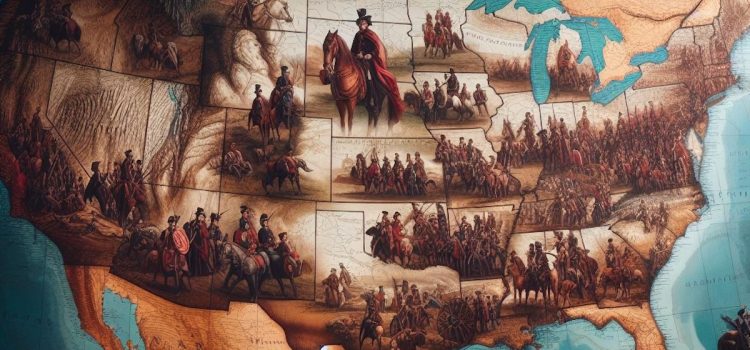

This article is an excerpt from the Shortform book guide to "A People's History of the United States" by Howard Zinn. Shortform has the world's best summaries and analyses of books you should be reading.
Like this article? Sign up for a free trial here.
How was the United States able to expand westward during its early history? What was the cost?
In his book A People’s History of the United States, historian Howard Zinn discusses the country’s economic and territorial expansion during the first half of the 19th century. He focuses on how it led to the displacement of American Indians and the Mexican-American War.
Keep reading to understand the territorial expansion of the United States from Zinn’s perspective.
The Indian Removal Policy
During the territorial expansion of the United States, the US conducted a policy of Indian removal, or the displacement and ethnic cleansing of American Indian tribes. The US carried out Indian removal through violence, exploitative treaties, and encouraging tribes to turn against one another to weaken resistance. Unlike during the colonial era, the main beneficiaries of Indian removal during the US’s expansion weren’t poor white frontiersmen. Instead, wealthy land speculators or railroad companies collaborated with the government, buying land that the US forced Indians off of. Then, they profited by developing the land, renting it out to poor farmers, or selling it for a higher price.
Indian removal policies were devastating economically, physically, and spiritually to Indian tribes. Many had lived off of their land for generations, accumulating knowledge of the area as well as cultural and religious ties to it. Once displaced, they often had to change their way of life—going from a hunting-based lifestyle to an agricultural lifestyle, for example—in an unfamiliar region. Many tribes resisted Indian removal in a number of ways, through violence, attempts to assimilate and integrate into American culture and life, or even legal means. While some of these attempts were met with limited or temporary success, none were able to stop or even significantly slow the process of Indian removal.
For example, in the Supreme Court case Worcester v. Georgia, the Cherokee Indian tribe fought to hold onto their land in Georgia. Although they won the case and the right to stay, President Andrew Jackson and the Georgia state government ignored the ruling. Not long after, the US government ethnically cleansed the Cherokee tribe, forcing them to march along the “trail of tears” to Oklahoma. Thousands died on the journey from cold, starvation, and disease.
The Mexican-American War (1846-1848)
Zinn argues the Mexican-American War was a conflict between exploitative elites over territory. As the US expanded west via Indian removal, some politicians began eyeing the neighboring territory of Mexico. The US annexed the breakaway Mexican state Texas in 1845, and then sent troops into Mexican territory to provoke a military response in 1846. When the Mexican army inevitably retaliated, the US declared war.
American soldiers were either impressed into service, or they joined for economic opportunities. While morale started high, it soon plummeted due to brutal conditions—disease was rampant, combat was bloody and chaotic, and promises of wealth turned out to be greatly exaggerated. Desertion was common; so was raping and robbing civilians. In the siege of Vera Cruz, US Naval ships indiscriminately shelled the city, mostly killing civilians, until it surrendered. Eventually, the US forced the Mexican government to surrender, seizing all Mexican territory north of the Rio Grande.
| US Influence Over Mexico After the War The US continued to be a significant force in Mexican politics from the end of the Mexican-American War to the present day, pushing for US interests through political and economic pressure as well as other direct military interventions. For example, the US supported the Mexican government financially and diplomatically during the French Intervention in Mexico, when France invaded and occupied large portions of Mexico to reclaim large outstanding foreign debt. In addition, US troops clashed with various factions and even invaded Mexico twice during the Mexican Revolution, albeit on a relatively small scale. These interventions and various US economic and political policies show that the Mexican-American War was just the start of American influence over its southern neighbor. |

———End of Preview———
Like what you just read? Read the rest of the world's best book summary and analysis of Howard Zinn's "A People's History of the United States" at Shortform.
Here's what you'll find in our full A People's History of the United States summary:
- A bottom-up view of American history focusing on the people, not the politicians
- How Indigenous people, Black Americans, women, laborers, and activists lived
- Why social movements of the 60s and 70s failed to create lasting change






